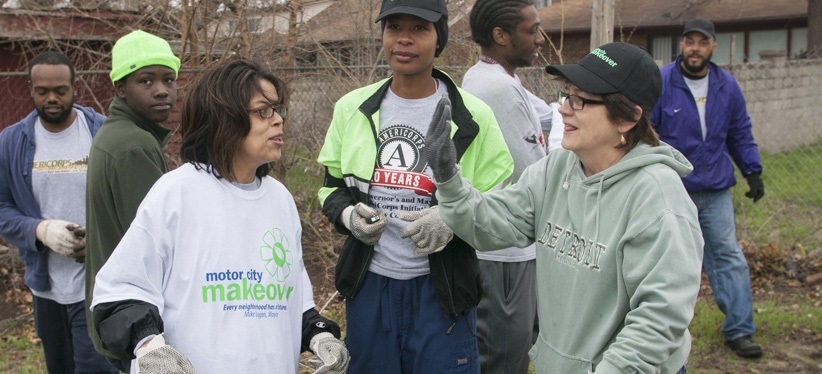Teaming up to Tackle Foreclosures
The Problem
Volunteer efforts to stabilize Detroit’s neighborhoods were happening in silos, creating inefficiency and impeding progress.
- Individual volunteers and staff leading service programs at large corporations and nonprofit organizations were all working to stabilize neighborhoods by mitigating blight and decreasing home foreclosures — but without any coordination.
- This disorganization led to inefficiencies and impeded everyone’s ability to make significant progress.
The Solution
The Chief Service Officer brought together diverse partners to unify volunteer efforts around a common strategy for mitigating blight.
- Inspired by conversations with other Cities of Service mayors,
 Detroit Mayor Mike Duggan appointed the city’s first Chief Service Officer, Victoria Kovari, who also serves as general manager of the department of neighborhoods for the city.
Detroit Mayor Mike Duggan appointed the city’s first Chief Service Officer, Victoria Kovari, who also serves as general manager of the department of neighborhoods for the city. - Kovari brought together citizen leaders and public and private partners to create a unified strategy. Together, they decided to focus on reducing foreclosures as a key tactic for mitigating blight and boosting Detroit’s population. The partners met monthly to share progress and trouble shoot challenges as necessary.
- The city identified 5,600 occupied homes at high-risk for foreclosures and launched a targeted campaign help them stay.
- Kovari and partners designed and implemented a door-to-door public outreach campaign and launched the Serve Detroit website to coordinate and boost volunteer participation.
- Volunteers provided crucial information about how to avoid tax foreclosure and promoted foreclosure prevention workshops in the neighborhood.
“Developing a citywide strategy with corporate, nonprofit, and city partners was transformative. We were able to focus resources on the areas of greatest need, and build infrastructure to support citizen engagement.”
Victoria Kovari, Chief Service Officer, City of Detroit
The Results
Two thirds of the homes visited as part of the outreach campaign were diverted from foreclosure, saving 3,700 families from displacement.
- Mayor Mike Duggan attributes this reduction to volunteers’ door-to-door campaign, and to the critical coordination that the CSO role provided.
- In 2015 there were 6,408 owner occupied foreclosures; in 2016 3,543, and in 2017 only 786 owner occupied homes were going through foreclosure. Also, in 2015 there were 9,111 total renter and owner occupied home foreclosures and now in 2017 there are only 1,915.
Explore more Chief Service Officer City Spotlights or learn more about Detroit’s Service Plan.

